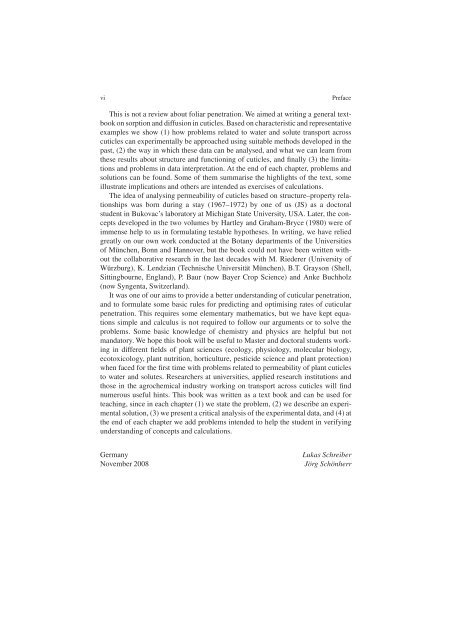Water and Solute Permeability of Plant Cuticles: Measurement and ...
Water and Solute Permeability of Plant Cuticles: Measurement and ...
Water and Solute Permeability of Plant Cuticles: Measurement and ...
Create successful ePaper yourself
Turn your PDF publications into a flip-book with our unique Google optimized e-Paper software.
vi Preface<br />
This is not a review about foliar penetration. We aimed at writing a general textbook<br />
on sorption <strong>and</strong> diffusion in cuticles. Based on characteristic <strong>and</strong> representative<br />
examples we show (1) how problems related to water <strong>and</strong> solute transport across<br />
cuticles can experimentally be approached using suitable methods developed in the<br />
past, (2) the way in which these data can be analysed, <strong>and</strong> what we can learn from<br />
these results about structure <strong>and</strong> functioning <strong>of</strong> cuticles, <strong>and</strong> finally (3) the limitations<br />
<strong>and</strong> problems in data interpretation. At the end <strong>of</strong> each chapter, problems <strong>and</strong><br />
solutions can be found. Some <strong>of</strong> them summarise the highlights <strong>of</strong> the text, some<br />
illustrate implications <strong>and</strong> others are intended as exercises <strong>of</strong> calculations.<br />
The idea <strong>of</strong> analysing permeability <strong>of</strong> cuticles based on structure–property relationships<br />
was born during a stay (1967–1972) by one <strong>of</strong> us (JS) as a doctoral<br />
student in Bukovac’s laboratory at Michigan State University, USA. Later, the concepts<br />
developed in the two volumes by Hartley <strong>and</strong> Graham-Bryce (1980) were <strong>of</strong><br />
immense help to us in formulating testable hypotheses. In writing, we have relied<br />
greatly on our own work conducted at the Botany departments <strong>of</strong> the Universities<br />
<strong>of</strong> München, Bonn <strong>and</strong> Hannover, but the book could not have been written without<br />
the collaborative research in the last decades with M. Riederer (University <strong>of</strong><br />
Würzburg), K. Lendzian (Technische Universität München), B.T. Grayson (Shell,<br />
Sittingbourne, Engl<strong>and</strong>), P. Baur (now Bayer Crop Science) <strong>and</strong> Anke Buchholz<br />
(now Syngenta, Switzerl<strong>and</strong>).<br />
It was one <strong>of</strong> our aims to provide a better underst<strong>and</strong>ing <strong>of</strong> cuticular penetration,<br />
<strong>and</strong> to formulate some basic rules for predicting <strong>and</strong> optimising rates <strong>of</strong> cuticular<br />
penetration. This requires some elementary mathematics, but we have kept equations<br />
simple <strong>and</strong> calculus is not required to follow our arguments or to solve the<br />
problems. Some basic knowledge <strong>of</strong> chemistry <strong>and</strong> physics are helpful but not<br />
m<strong>and</strong>atory. We hope this book will be useful to Master <strong>and</strong> doctoral students working<br />
in different fields <strong>of</strong> plant sciences (ecology, physiology, molecular biology,<br />
ecotoxicology, plant nutrition, horticulture, pesticide science <strong>and</strong> plant protection)<br />
when faced for the first time with problems related to permeability <strong>of</strong> plant cuticles<br />
to water <strong>and</strong> solutes. Researchers at universities, applied research institutions <strong>and</strong><br />
those in the agrochemical industry working on transport across cuticles will find<br />
numerous useful hints. This book was written as a text book <strong>and</strong> can be used for<br />
teaching, since in each chapter (1) we state the problem, (2) we describe an experimental<br />
solution, (3) we present a critical analysis <strong>of</strong> the experimental data, <strong>and</strong> (4) at<br />
the end <strong>of</strong> each chapter we add problems intended to help the student in verifying<br />
underst<strong>and</strong>ing <strong>of</strong> concepts <strong>and</strong> calculations.<br />
Germany Lukas Schreiber<br />
November 2008 Jörg Schönherr







